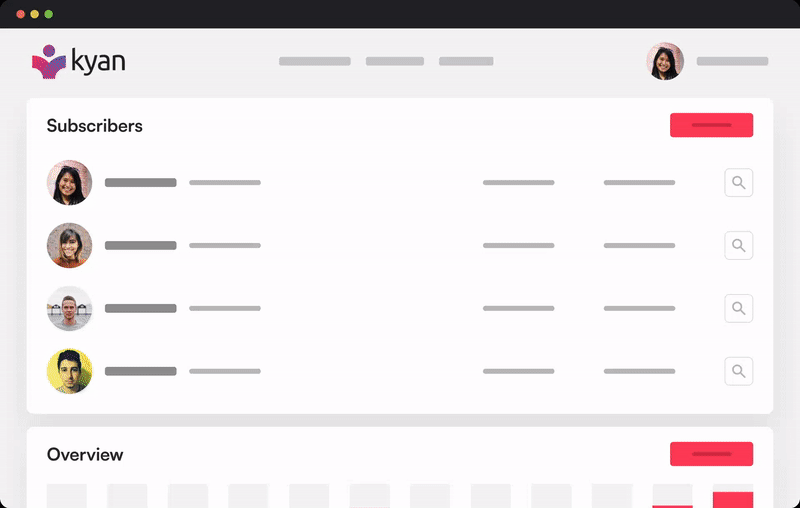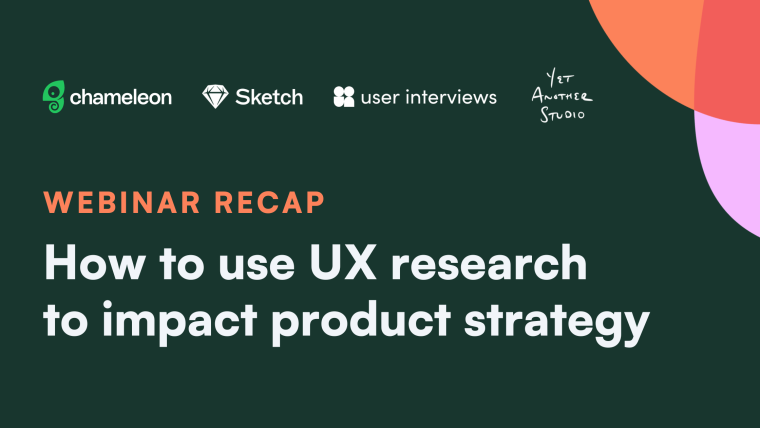We’ve said it once and we’ll say it again: the only way to accurately determine what your users want is to ask them.
The more often you ask them, the more up-to-date and relevant your insights are —introducing: continuous research.
Continuous research is how product managers, growth managers, and product teams get actionable user insights to inform day-to-day decision-making. Research is the backbone of any data-driven, customer-centric organization, and continuous research ensures you’ve always got your finger on the pulse when it comes to user wants and needs.
In this article, you’ll learn about continuous research and why it’s important, as well as the latest trends and insights that you should be aware of.
Continuous research is how product teams make better decisions.
Insights show that more and more teams are adopting continuous research as a habit.
Continuous research is increasingly important in the fast-changing landscape of today’s world.
Product Managers are key drivers of continuous research and solution development.
What is continuous research?
Continuous research refers to the process of eliminating assumptions and biases in decision-making by remaining in continuous contact with users. Continuous research methods can be qualitative or quantitative and include user interviews, product surveys, usability testing, product analytics, and more.
Continuous research is typically exploratory—it doesn’t start with specific, project-based questions, topics, or briefs. Continuous research starts with a desire to improve the product by listening to users via market research, UX research, or any other research.
Is there a difference between continuous research and continuous discovery?
“I don't think so—any real difference is splitting hairs.”
This is the answer we got when asking Zack Naylor, Co-Founder at Aurelius, about his opinions on the difference between continuous research and continuous product discovery.
“The main goal when someone references either of those is keeping close contact with your customers and a continued understanding of their needs in order to inform your design and product decisions.” - Zack Naylor, Co-founder at Aurelius
Different teams often have different terms for the same concepts or processes—and it appears that this is the case for continuous research and continuous discovery. Some teams consider them to be the same thing, whereas others differentiate between the two. For example, here’s what we got when asking Ryan Mckenzie, Co-Founder and CMO at Tru Earth and long-time product geek, the same question.
“Yes, there’s a difference.
Continuous research involves ongoing data collection from various sources that can be used to inform decisions about product design, development, and launch strategies.
Continuous discovery focuses on uncovering customer insights through experimentation and iteration with prototypes or existing products in order to identify key areas of improvement.”
- Ryan McKenzie, Co-Founder and CMO at Tru Earth
Ryan and Zack are both right, and each opinion is based on their own experience in different product teams and organizations. Ultimately, it comes down to how you and your team define them—as long as you’re all on the same page with the process, you’re good to go.
Why is continuous research important for product managers?
The product manager role is a pretty broad one—and it’s only getting broader. Let’s put it this way—15 years ago, Ben Horowitz called product managers the ‘CEO of the product’—someone who takes full responsibility for the product and everything to do with it. With better tools and more knowledge—the PM role is only expanding as time goes on.
Product managers have their hands in many cookie jars: user experience, product engineering, business development, and more. They oversee all things product—it’s a big job with big responsibilities.
Continuous research is how product managers set themselves up for success. It provides the strong foundations needed to build effective products that meet user needs and enables proactive product development. It also helps product managers:
Find your why
Put simply, continuous research ensures you’ve always got an answer to the question: why?
Q: Why should we cut the user onboarding tour down to three steps?
A: Because research found that users drop off after the third step.
Q: Why are users not engaging with a specific feature?
A: Because research found they don’t know it exists.
Q: Why should we redesign the menu layout?
A: Because research found that users don’t understand how to navigate the product.
This process of question and answer is typically reverse-engineered, as the why comes first in the form of a problem users have and then product teams ideate ways to solve the issue with product development and updates.
If PMs don’t speak to users, they don’t have a grasp on the problems that should drive product development. “Because research found…” should be your new go-to when considering the why behind product development decisions.
Get a wider perspective and build together
Continuous research enables you to keep an eye on everything. As opposed to customer research that has a specific purpose, continuous research allows you to get a strong overview of the user landscape without the pressure of getting specific data.
It also ensures you keep users at the heart of your product development process, which is an absolute must for user-centric companies. Your goal should be to build together—think of it as a road trip: users are passenger-seat navigators guiding the way, and product teams are the drivers getting from A to B.
Keep up with the changing landscape
We live in a VUCA world… volatile, uncertain, complex, and ambiguous. This means things change often, and they change fast. Continuous research is the only way to stay on top of the evolving needs and wants of your users.
Everything’s connected, and although you may predict a shift in the PEST environment to have no impact on your users—the research could quickly reveal you’re wrong. Keeping a constant eye on customers is the only way to ensure you’re giving them an optimized product experience.
5 Key benefits of continuous research
So, how does continuous research impact product development? Here are five benefits of continuous research for product development teams.
Make better product decisions
Let’s start with the obvious. More research means more-informed product decisions and more-informed decisions mean better decisions. Unlike researching for a specific purpose, continuous research opens the door to unrequested user or product feedback.
This continuous feedback can uncover answers to questions you never thought to ask; insights that can be applied to decisions across the product and wider organization, such as in sales, marketing, and customer service teams.
Having a constantly-expanding repository of user research is key to well-informed product decisions. More research = a stronger understanding of users, so the more data points you have, the better.
Continuous research enables you to gain a deeper understanding of users and keep your finger on the pulse when it comes to user satisfaction and insights. It’s like comparing the data collected from a single snapshot, to those collected from a continuous live stream.
Act fast when necessary
Another benefit of continuous research is that it enables you to act fast. Research is a notoriously time-consuming process when approached on a project-by-project basis, but building research into your day-to-day ensures you’ve got the information you need, when you need it.
Identify new product opportunities
Continuous research also enables you and your team to proactively identify product opportunities. If research uncovers the early signs of dissatisfaction, you can quickly investigate further and create a solution.
It’s also great for identifying entirely new opportunities, as you never know what ideas one comment could spark. Maybe your research found that users wish your product could do XYZ and maybe you have the knowledge and tools to make that wish come true.
Prioritize product development activities
Product development is never-ending. A product can always be improved. Deciding on what to improve next, however, can be tricky. It’s about identifying the highest impact developments to your product.
These are the developments that make the biggest difference to users on a day-to-day basis and the changes that improve their experience with your product.
The current state of continuous research in product teams
Continuous research is a hot topic right now, and there’s lots of interest surrounding its future in product teams. We’ve taken a look at the latest research from Maze, the continuous product discovery platform, which identified some key trends and insights for the future of continuous research.
Insight #1: Continuous research is becoming a well-established practice
Here are some stats to consider:
77% of Maze’s audience conducts a new research study at least monthly, 9% of respondents report running a new research study daily
78% of product professionals believe their company doesn't do enough research studies or could do more studies
Companies are investing more and more time and energy into research, and are adopting a more continuous approach to gathering user insights. Take a look at this visual detailing the percentage of respondents that conducted research at each product development stage.

Interestingly, 83% of respondents said research should be conducted at every stage of the product development cycle, but only 36% of product teams conduct research studies after launch.
However, when product managers are involved, this number rises to 44%, indicating that PMs are key drivers of post-launch research.
Insight #2: The industry is moving towards the democratization of research
More and more teams are conducting research as the need for insights in organizations grows. Here’s a snippet from the study where Caitlin McCurrie, Research Lead at Atlassian, shares their thoughts on why this is:
“While I strongly believe that dedicated research professionals are a necessary component for a successful tech company, there will never be enough researchers to cover the range and volume of research needs within an organization.” - Caitlin McCurrie, Research Lead at Atlassian
As companies become increasingly data-driven and customer-centric, the need for insights pushes all teams to engage with and conduct user research, primarily user interviews (65%) and user surveys (59%). Take a look at the other most frequently used research methods:

Insight #3: Teams are increasingly adopting continuous research to enable more effective decision-making
This one comes as no surprise to us as we’re huge advocates of research as a guiding force for decision-making. Turns out, we’re far from the only ones—74% of respondents believe research is partially effective or effective in determining decision-making.
Designers rely on product research to make decisions the most (74%), then it’s:
Product teams (67%)
Engineering (40%)
Marketing (34%)
Data (31%)
Sales (17%)
Customer support (16%)
The research also found that product teams who conduct research more often report more effective decision-making. We’re not surprised, are you?
When it comes to researching research habits in organizations, Maze isn't the only team uncovering great insights. Teresa Torres, founder of Product Talk, released the results of their inaugural CDH Benchmark Survey, where they asked teams about their discovery habits.
Here are some key insights and takeaways from the study that reflect the growing importance of continuous research:
When asked ‘When was the last time you talked to a customer?’, 45.3% of respondents said ‘in the past week’. Businesses are more in touch with customers than ever, however, this doesn’t specify how they spoke with them—a sales call isn’t the same as a customer interview, for example.
When specifically asked ‘When was the last time you conducted a story-based interview?’, 16.3% responded ‘in the past week’. Not quite the original 45%, but still encouraging and a strong indicator of the increasing reliance on continuous research, especially when paired with the 22% of respondents that reported having conducted story-based interviews ‘in the past month’.
77.6% of respondents said they’d identified opportunities in the last customer interview they conducted. Although Teresa identifies this question as an area for improvement, saying it would have been better to ask those who responded affirmatively to share an opportunity from their last interview. An opportunity was defined to respondents as ‘an unmet customer need, pain point, or desire’. That’s a great figure to highlight the value in user insights.
When asked ‘How many opportunities is your team working on right now?’, 39.3% responded ‘three or more’, and 26.1% stated they’re working on two opportunities. For those opportunities, solutions were most commonly contributed by a team’s product manager (84.1%), engineers (66%), and designers (63.5%). The question was a ‘check all that apply’, not a single select (if you’re wondering how those stats make sense.)
Get more insights, more often
The benefits of continuous research are clear: better insights, proactive solutions, and deeper connections with users. The question isn’t if you’ll implement continuous discovery, it’s when.
The sooner you create a continuous research workflow, the better. You’ll be in a stronger position to make data-driven decisions—and better positioned to create problem-solving solutions.
If you want to start collecting in-product user feedback, sign up today to get instant access to the Chameleon Playground. Use perfectly-placed in-app Microsurveys to get the feedback you need, and create launchers, tooltips, and more to provide contextual support where necessary.
Let's get it going!

Create Microsurveys for continuous in-product feedback
Easily build no-code in-app surveys to collect contextual and targeted user feedback. Try for free.





